

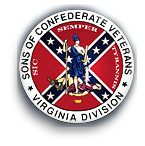
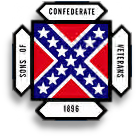

SCV Blog!
SCV Facebook Page!

Do you have any questions or comments? Do you see anything on the web site that you would like to add or change?
Celebrate 150 Years of Heritage -

Web Site Updated 9/16/2011 8:44:00 PM


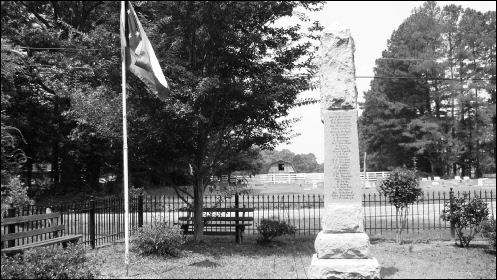

Copyright © 2011. All Rights Reserved. Norfolk County Grays, Camp #1549, Sons of Confederate Veterans.
The Jackson Greys
Notice: The following information is provided with the knowledge and consent of former Norfolk County Grays Compatriot, Neale Clifton, who has graciously allowed us to repost the wealth of information about and research on the Jackson Greys, which is displayed on his web site. Feel free to explore his original web site, as it is very informative and contains a voluminous amount of historical information, much of which is local. Please follow this link to go directly to his original publication: Neale Clifton’s Jackson Greys Web Site
History
In the early summer of 1861, Samuel M. Wilson of Norfolk, VA received the authority to raise a regiment for heavy artillery service, for the protection of Norfolk and Portsmouth. Only eight companies of the unit had been organized by the time that these two cities were evacuated. These eight companies were reorganized at the Jarrett's Hotel, Petersburg, VA, as an infantry battalion as their services were no longer needed as artillerymen. As an eight company battalion, the organization was known as the Seventh Virginia Infantry Battalilon. After two additional companies were added to the battalion, bring it up to the authorized strength of a regiment, it was mustered into the Confederate service as the 61st Virginia Infantry on October 1, 1862.
Samuel M. Wilson, the organizer of the original unit, appears to have held the rank
of Lieutenant-
Although the entire 61st Virginia Regiment is of great interest to me, my special interest is for the first company, Co. "A." This company was recruited in the St. Bride's Parish of Norfolk County, in the section known as Pleasant Grove Magisterial District and was organized at Pleasant Grove Baptist Church on June 1, 1861. The company left Pleasant Grove on the 10th of July and marched first to Norfolk, where they paraded up Main Street to Custom House. There they were met by Major E. Bradford, the mustering officer, and on 11th of July, were mustered into the Confederate States, and on the 12th of July they took the ferry to Portsmouth and were quartered in the Norfolk County Courthouse.
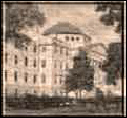
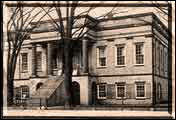

Custom House
Norfolk, Virginia
Norfolk County Courthouse
Portsmouth, Virginia
Naval Hospital
Portsmouth, Virginia
Their officers at that time were:
Captain, William H. Stewart; First Lieutenant, William C. Wallace; 2nd Lieutenant, John T. West; 3rd Lieutenant, George T. Hodges.
The "Jackson Grays" were named for Mr. James P. Jackson, the proprietor of the Marshall
House in Alexandria, Virginia, who was killed in that city on the 24th of May 1861,
for defending the flag he had raised over his hotel. That day, a large force of Federals,
numbering eight or nine thousand men, had crossed the Potomac River early in the
morning, and occupied the town. Seeing the Confederate flag flying at the top of
the staff on the hotel, Colonel Ellsworth, of Chicago, commanding a regiment of Fire
Zouaves of New York City went up to the top of the building, with several men from
his regiment and took it down. As he was descending the stairs, Mr. Jackson, who
had been aroused by the noise came out from his bedroom with a double barrel gun
and asked for the cause of the commotion, Colonel Ellsworth pointing to the flag
in his possession said "This is my trophy." Mr. Jackson replied, "and you are mine,"
and immediately fired, killing Ellsworth dead. Colonel Ellsworth's companions returned
the fire, shooting Mr. Jackson and running a bayonet into him, killing him. Mr. Jackson
had became a martyr to the Southern cause. 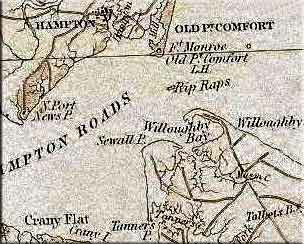
After remaining at the Norfolk County Courthouse for a few days, the Grays were ordered
to the batteries at Fort Nelson, on the grounds of the present Portsmouth Naval Hospital
and remained on duty there, until December, 1861, when at there own request, they
were sent to Sewell's Point and put in charge of a masked battery of six heavy rifled
guns of the six-
They were the most advanced battery amongst the defenses of the harbors of Norfolk and Portsmouth, and were within range of the Federal guns. Daily, around noon, the Union artillerymen at the Rip Raps shelled the Point with their Sawyer Gun. This was very annoying to them as they were not allowed to reply with their guns. Most of the shells buried in the sand without exploding and were dug up by the troops. After waiting and watching from December, 1861 to March, 1862, the opportunity finally came and they joined in the first battle of the ironclads.
When the Confederate ironclad CSS Virginia, went down to Hampton Roads and had her
battles with the Union fleet on the 8th and 9th of March, 1862, the battery took
part, with two rifled six-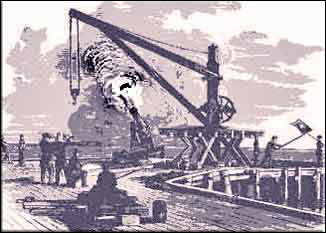 den
died a few weeks after the battle at the naval hospital from the effects of his injuries.
den
died a few weeks after the battle at the naval hospital from the effects of his injuries.
In the early morning of tenth of May, 1862, the company had to abandon their batteries by order of General Huger and they formed the rear guard of the troops that fell back upon Norfolk. Union General John E. Wool landed on Willoughby's Spit with six thousand troops later in the morning of the tenth of May and began a his march to Norfolk. This forced an hasty evacuation of all the fortifications at Sewell's Point. When the rear guard passed Indian Pole Bridge, it was set on fire so that when General Wool and his troops reached that point, they were unable to cross the creek. General Wool was compelled to countermarch his troops delaying his entry into Norfolk until 5:00 p.m. which gave the Confederate troops time to evacuate the City. The "Jackson Grays" marched through Norfolk and then crossed the ferry into Portsmouth and was one of the last commands which left Portsmouth by railroad, being moved out on flat cars late in the afternoon of the same day. Only one company remained after the departure of the Jackson Grays, namely the Portsmouth Rifle Company, and they marched out of Portsmouth to Suffolk.
Upon the reorganization of the company in Petersburg, Virginia, it was assigned to
duty with the 61st Virginia Regiment as Company "A." At that time the regiment was
under the command of Lieutenant-
On the last day of August, the Grays were marched to Richmond, where they boarded the Orange and Alexandria Railroad for Gordonsville. For the first two weeks of September, the Grays worked as carpenters and laborers constructing a bridge spanning the Rapidan River. While there, upon one occasion, while scouting near Bristoe Station, they met a Federal brigade belonging to Sigel's Corps, accompanied by a battery of artillery and a company of cavalry. Under cover of a forest, which concealed the smallness of the Confederate forces, an attack was made upon the Federals who were repelled. The company captured several prisoners and withdrew without having suffered any loss. At a nearby station, the Southerners found a number of derailed locomotives, cars and other railroad material. On the 17th of September, the men hoisted the engines and other cars on the track and the trains rumbled back to Richmond,
Simultaneously, Federal cavalry, under D. B. Birney proceeded to the area to retrieve the bodies of fallen Union soldiers. The cavalry appeared under a flag of truce before the pickets requesting permission to bury or remove their dead. Maj. William H. Stewart who was in command doubted Birney's intentions. Stewart believed Birney’s mission was to gather intelligence and discover the strength of the Southerners, therefore he refused to receive the flag of truce without first communicating with the authorities in Richmond. Stewart hastened his men to their tasks and then loaded the infantry onto flat cars. The Confederates were pulling away as the Union horsemen charged onto the scene.
After the return of General Lee's army from Maryland in October 1862, the Jackson Grays, with the rest of the 61st Virginia Regiment were assigned to Mahone's Brigade, and became a part of the Army of Northern Virginia. The 61st joined the 6th, 12th, 16th, and 41st Virginia to complete Mahone's organization. Mahone's unit and Perry's, Wilcox's, Featherson's and Wright's brigades composed Major General Richard H. Anderson's Division in General Longstreet's Corps. At the time, Longstreet's Corps and General Stonewall Jackson's Corps made up the infantry components of Lee's Army of Northern Virginia.
On the evening of the 15th of November, 1862, General Robert E. Lee directed Brigadier
General W. H. F. Lee to order the 61st Virginia Regiment which included Mahone's
Brigade to proceed immediately to Fredericksburg. These troops promptly moved as
directed by General Lee and reached Fredericksburg on the 18th day of November. On
the night of the 18th the troops were distributed throughout the woods and built
many bon-
From that time on the Grays became a part of the Army of Northern Virginia, and took
part in all of its battles, vict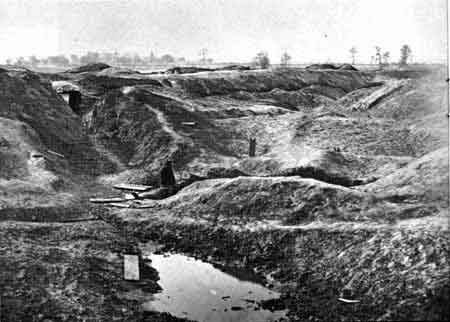 ories and marches.
ories and marches.
Of all the Jackson Grays triumphs, the Battle of the Crater was the most dramatic. Union miners and engineers tunneled under the Confederate lines and positioned tons of powder to blow a hole in the Confederate defenses. On the morning of July 30, 1864, the Union miners lit the fuse and exploded the powder. A horde of Union soldiers then poured out of their earthworks and into the Southern trenches.
General Mahone directed Anderson's Division in a great counterattack. The Savage
hand-
The Jackson Grays surrendered with fifteen men, which included three Sergeants, three Corporals, and nine Privates, at Appomattox Court House on the 9 of April 1865 and one of the 61st Regiment flags is still on display at the Appomattox National Park.
Of the commissioned officers of the company, not one escaped the shots of the enemy. Captain William H. Stewart, its first captain was promoted to Major
and then to Lieutenant-
After the war, men of the grays joined the United Confederate Veterans camps, such
as the Stonewall Camp, of Portsmouth, the Pickett-
On June 1, 1905 at the Pleasant Grove Baptist Church Cemetery, a Confederate Monument was unveiled by the living veterans of the Jackson Grays and dedicated to all of the men of the Jackson Grays. It is a granite monolith, which stands approximately eight feet tall. It contains a commemoration and a list of the men of the Jackson Grays. It is the only known Confederate Monument in the City of Chesapeake.
Aftermath. Battle of the Crater as it looked in 1865.
Roster of Soldiers in the Jackson Greys
Captains
William H. Stewart, Lt Col.
William C. Wallace
John T. West
Lieutenants
George T. Hodges
Camillus Albert Nash
Sergeants
William A. Dudley
Dr. Henry Shaw Etheridge
William A. West
Corporals
Laban Mansfield
George D. Old
Peleg Pritchard
Thomas Henry Sykes
Musicians
William Mahoney
James Toy
Privates
George Warden Bright
James Henry Butt
Jeremiah Castine
John T. Castine
Alexander P. Cooper
Columbus C. Cooper
John A. Cooper
Caleb Creekmore
Isaiah Creekmore
John W. Creekmore
Marshall Creekmore
Willoughby W. Creekmore
John Culpepper
Daniel M. Culpepper
Daniel R. Culpepper
Ashwell Curlin
John W. Deford
Benjamin F. Diggs
Abner Grandy Duncan
Isaac Eason
Dennis Etheridge
John Ferrell
Acelius G. Foreman
Cary Foreman
William A. Foreman
William H. Foreman
James Fulford
James E. Fulford
Jacob A. Grimes
John F. Grimes
Franklin Gwinn
James P. Halstead
Thomas E. Halstead
William H. Harrison
Follow link to Neale Clifton’s Roster Page
Privates -
Caleb Hodges
Isaiah Hodges
Thomas H. Hodges
John Humphries
Lemuel Jennings
Noah M. Jennings
Wickers P. Jennings
Alexander Old Lee
Abner Lewis
John Lynch
Leroy G. Lynch
Simon Mathias
Samuel M. Mercer
James H. Miller
John J. Miller
Lovitt Miller
Andrew C. Morgan
Wiley P. Morgan
Thomas O. Murphy
Cincinnatus A. Nash
Henry E. Nash
William Oniel
Narariah Only
Charles N. Overton
Grandy Overton
Joseph H. Pritchard
Peleg Pritchard
Wiley Pritchard
William Pritchard
William M. Reed
Joseph Scott
William T. Scott
Ethelbert H. Sivells
Daniel T. Sivills
Benjamin F. Spraight
Henry C. Sykes
John C. C. Sykes
Joseph Sykes
Josephius Sykes
William O. Sykes
Richard Thompson
George W. Waller
James Warden (Ward)
William H. Warden
John T. West
Leroy McCain West
William W. West
Martin Van Buren Whitehead
Robert B. Whitehurst
Willoughby W. Whitehurst
Dorustus A. Williams
James E. Williams
Marcellus W. Williams
Joseph N. Wood
Keeling Wood
Leander Woodard
James T. Woodard
Peter Wright